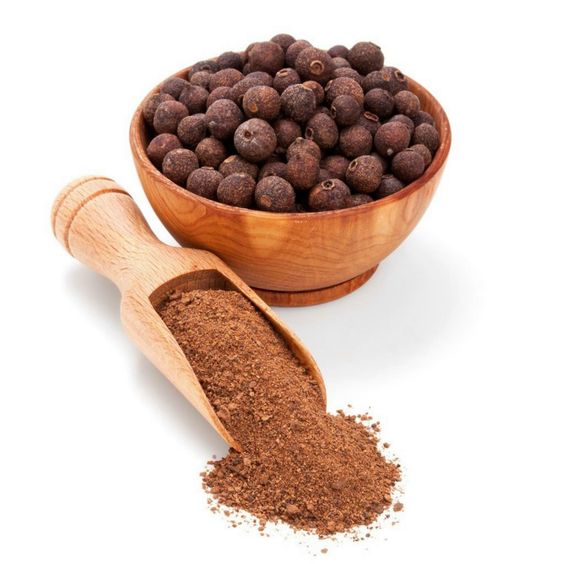Herbs and Spices - Allspices

Allspices
Allspice which is also called Jamaica pepper, Kurundu, Myrtle pepper, pimento, allspice berries, or newspice is a spice that is the dried unripe fruit of the Pimenta dioica plant, native to the West Indies, southern Mexico and Central America. It is an evergreen tropical shrub belonging to the Myrtaceae family and in the genus: pimento.
Originally it was named "pimento", Spanish for pepper, by the explorers in the 16th century due to its dark brown and wrinkled skin. Later on, the English renamed it allspice because it has hints of pepper, cloves, cinnamon, nutmeg, and juniper. It was gradually spread throughout the world because of its special flavor as well as its healthy quality.
Normally berries are picked when they’re ripe and allowed to dry in the sun, ending up as the somewhat shrunken, hard berries known as allspice. Later these are ground up into spice for culinary use, or the essential oil can also be extracted. Allspice is found used in baking, mostly mincemeat and mixed pickling spice since ancient times till now.
It is especially used in both sweet and savory dishes, in Jamaican Jerk sauce, stews and desserts in the Middle East, as well as the key flavoring in liquors Chartreuse and Benedictine. Allspice has a long history in folk medicine in the Caribbean and Central American. It is brewed into a tea to relieve colds, ease menstrual cramps, and calm an upset stomach. As a balm, allspice is applied to bruises, sore joints, and muscle aches. It is indeed having a wide ranges of beneficial properties.
Benefits:
1. Increase bones density and bone repair: Allspice consists of considerable amount of manganese which is extremely essential for healthy growth of human bones. Osteoporosis and arthritis are few of the possible problems related with manganese deficiency. Manganese that we consume is stored in bones, liver and kidney and any insufficiency of manganese may directly affect these organs as well as their actions. Allspice is an essential ingredient that adds to bone density and bone repair.
2. Anti-Inflammatory qualities: One of the most important features of allspice is its capability to lower inflammation and relieve pain in parts of the body. The active ingredients within the spice have chemical compounds which eliminate inflammation, making it perfect spice to give you some relief from arthritis, gout, muscle aches, or even hemorrhoids. Apart from that allspice has certain analgesic components which allow for pain reduction in the case of injury or surgical recovery.
3. Facilitate healthy digestion: Allspice has calming, rubefacient effects which make it perfect for comforting the stomach and also facilitating healthy digestion. Eugenol found in allspice help to eliminate digestive problems like constipation, diarrhea, nausea and vomiting, while also encouraging regularity, which can help to reduce bloating and excess flatulence. The anti-inflammatory feature of allspice also eases cramps, which can ease the entire process of digestion
4. Cancer Prevention: Researches have shown that consuming calcium rich foods are linked with a reduced risk of colon and rectal cancers. Allspice consists of 661 mg of iron which is 66.10% of the daily recommended value. So include calcium rich food to remain safe from cancer.
5. Blood circulation: Allspice contains significant amount of copper and iron that is ideal for enhancing circulation, since these are important components of red blood cells. Iron also functions in the formation of certain enzymes which are crucial for general metabolism
6.Dental Health: The antimicrobial, antibacterial, and antiseptic features of allspice help to enhance dental health though gargling with this spice wouldn’t be mostly pleasing, it has been related to healthier dental and gum health by protecting against bacterial pathogens.
Serving ways:
• In Caribbean soups, stews as well as curries.
• In pickling blends.
• In chutneys, jams, pickles, preserves as well as marinades.
• In mulled wine along with other kind of hot punch or beverage.
• In cakes and biscuits.
• In milk puddings as well as desserts.
• In fruit pies, crumbles, compotes and sauces.
• In bean soups or pulse dishes.
• In sausage mixture and also meat pies or pasties.
• In meat rubs and marinades.
• In pâtés and terrines.
• In ice creams and alcoholic liqueurs.
• In flavoring chocolate or hot chocolate.